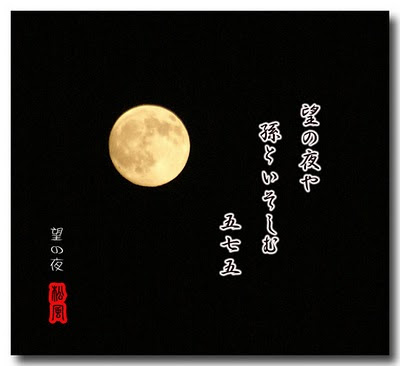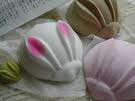:::::::::::::::::::::::::::::::::::::::::::::::::::::::::::::::::::::::::::::::::::::::::::::::::::::
The Moon, O-Tsukisama, Der Mond, La Lune
On this page you find links to the various worldwide kigo and information connected with the moon, in alphabetical order.
Here we also collect haiku about the moon, "Mr. Moon",
o-tsuki sama お月様.
The Moon belongs to the category of "Heaven", naturally.
But some activities around the time of the full moon in Autumn in Japan belong to the categories of Humanity or Observance.
The word MOON without further connotation,
refers to the AUTUMN MOON in Japanese haiku.
a wobbely moon
a wobbely viewer
tonight we get drunk
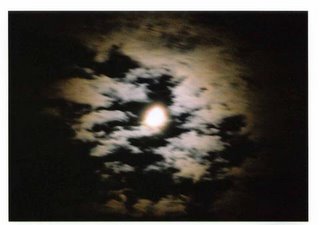
When I moved out to the countryside, I realized the importance of the moon . . .
Here are no streetlights, no neighbours, no nothing - so at night it is pitch dark.
This is the situation in the world and in Japan before the arrival of Electricity.
Therefore a moonlit night is most welcome, to be up a bit longer, not fear the demons and devils of the dark, sit with friends and compose poetry !
Gabi Greve, 2004
:::::::::::::::::::::::::::::::::::::::::::::::::::::::::::::::::::::::::::::::::::::::::::::::::::::
- Matsuo Basho told his disciples:
. . . behold the clouds over the east bank of the Yangzi River
when you are looking at the moon above the Kasai shore.
The "East Bank of the Yangzi River" refers to Huiji, where Li Bo spent time composing poetry.
source : Peipei Qiu: Basho and the Dao
. Chinese background of Japanese kigo .
:::::::::::::::::::::::::::::::::::::::::::::::::::::::::::::::::::::::::::::::::::::::::::::::::::::
Snow, Moon and Blossoms, Setsugekka - 雪月花 setsugetsuka
Japanese Art and the Japanese View of Nature
To the Japanese mind, nature is more than just physical scenery.
The Japanese love of the imperfect stems from an acknowledgment of the inherent limitations of human creative powers.
© SETSUGEKKA, by Isamu Kurita, MOA
..... Do not miss to read the full essay .
:::::::::::::::::::::::::::::::::::::::::::::::::::::::::::::::::::::::::::::::::::::::::::::::::::::
We have only to say "the moon" when we refer to the autumn moon. We must therefore put such epithets as "spring/vernal", "summer", or "winter" before the moon when we mention the other season's moon.
Takashi Nonin
Read more.
http://www.haikupoetshut.com/themoon.html
:::::::::::::::::::::::::::::::::::::::::::::::::::::::::::::::::::::::::::::::::::::::::::::::::::::
Apogee and Perigee of the Moon
Apogee and perigee refer to the distance from the Earth to the moon. Apogee is the furthest point from the earth. Perigee is the closest point to the earth and it is in this stage that the moon appears larger. Looking at the moon in the sky without anything to compare it to, you wouldn't notice any size difference. But the difference in size can in fact be quite significant.
Effects of Apogee and Perigee
The apogee and perigee of the moon have an effect on the tides here on Earth. When the moon is at apogee, the furthest distance from the Earth, it has less gravitational pull which, along with other factors that influence the tides, can contribute to lower tides or lower variation in the high/low tide level. When the moon is at perigee, closer to the Earth, there is much more gravitational pull which contributes to the opposite effect: higher tides or greater variation in the high and low tide.
source : www.moonconnection.com
snow moon
behind the old tree ...
what a sight !
Gabi Greve, January 10, 2009
:::::::::::::::::::::::::::::::::::::::::::::::::::::::::::::::::::::::::::::::::::::::::::::::::::::
. Tsuki Jinja 調神社 "Moon Shrine" .
waiting for the moon on the 12th day of the 12th month
juuninichi machi 十二日まち
:::::::::::::::::::::::::::::::::::::::::::::::::::::::::::::::::::::::::::::::::::::::::::::::::::::
Japanese Names for the Lunar Months
Since lunar months and solar years do not coincide, the actual beginning of the each lunar month varied from year to year. Most lunar months have two or three names.
Each lunar month has its full moon on the 15th day.
Find the list here:
WKD . Asian Lunar Calendar System
ooo ooo ooo ooo ooo ooo ooo ooo ooo ooo ooo
meigetsu no hoo e korobasu makura kana
I shift my pillow
closer to the
full moon.
Saiba 1858 (Tr. Hoffmann)
By the old Japanese lunar calendar, the full moon was always on the fifteenth of the month; and the eighth month would be our September. Just as a brief aside here, although the Japanese, from a Buddhist standpoint, like the full moon, from an aesthetic standpoint they also like the moons of the thirteenth and the seventeenth as well, because these moons were slightly misshapen from total fullness.
Autumn in Japan by the old lunar calendar consisted of the seventh, eighth, and ninth months (our August, September, and October). The most significant full moon of the lunar year was the full moon of the eight month (September), the Harvest Moon.
Larry Bole
Translating Haiku Forum
As the full moon rises
The swan sings in sleep
On the lake of the mind.
source : Epitaph of Kenneth Rexroth
:::::::::::::::::::::::::::::::::::::::::::::::::::::::::::::::::::::::::::::::::::::::::::::::::::::

by Tsukioka Yoshitoshi 月岡芳年
名月や来て見よがしのひたいぎわ
meigetsu ya kite miyogashi no hitaigiwa
The full moon
coming with a challenge
to flaunt its beautiful brow
Tr. John Stevenson
Fukami Jikyu
source : www.myjapanesehanga.com
Autumnal Moonlight Viewing
tsukimi 月見
There is an old custom of celebrating the full moon on the fifteenth day of the eighth month on the traditional Japanese calendar. It's a very poetic and elegant practice, with people placing ornaments and offerings next to windows, on verandas, and in other places where one can see the moon. Vases are filled with pampas grass and autumnal herbs, and seasonal foods like dumplings, pears, persimmons, and grapes are placed on dishes.
Autumn consisted of the seventh, eighth, and ninth months of the year on the old Japanese calendar. The full moon in the middle autumnal month, called chushu no meigetsu, was considered particularly beautiful, as the air became crisper and the heat of summer subsided.
The traditional Japanese calendar and the modern one used by countries around the world today are off by about a month. It's not unusual for chushu no meigetsu to be a day or two off from the day of the full moon.
The practice of celebrating the full moon came from China during the Heian period (794-1185). Records show that chushu no meigetsu was marked with poetry and music by court aristocrats as early as 909.
In the Edo period (1603-1868) the practice of enjoying the beautiful rays of the moon spread to warriors and townspeople. Farmers also incorporated viewing the full autumn moon into agricultural rites. For instance, taro roots (sato imo) were prepared as offerings, and moon-viewing doubled as a harvest festival. This became so widespread that the full moon in mid-fall also came to be known as imo meigetsu.
Eating dumplings - made from rice pounded into paste and shaped into spheres like the moon - made people feel like they were sharing a meal with the lunar god.
There used to be a custom forgiving anyone who stole the dumplings and fruits offered during moon-viewing. When the offerings were taken by children, they weren't scolded. Instead, adults said they were glad the gods liked the food so much to partake of them. This tradition is disappearing today, but the offered foods are still a treat for kids when the moon-viewing is over.
© Kidsweb
http://web-jpn.org/kidsweb/calendar/september/moon.html
:::::::::::::::::::::::::::::::::::::::::::::::::::::::::::::::::::::::::::::::::::::::::::::::::::::
The Chinese Moon Festival
The Chinese Moon Festival is on the 15th of the 8th lunar month. Now it is celebrated sometime between the second week of September and the first week of October. It's also known as the Mid-autumn Festival. Chinese culture is deeply imbedded in traditional festivals. Just like Christmas and Thanksgiving in the West, the Moon Festival is one of the most important traditional events for the Chinese.
The Moon Festival is full of legendary stories. Legend says that Chang Er flew to the moon, where she has lived ever since. You might see her dancing on the moon during the Moon Festival. The Moon Festival is also an occasion for family reunions. When the full moon rises, families get together to watch the full moon, eat moon cakes, and sing moon poems. With the full moon, the legend, the family and the poems, you can't help thinking that this is really a perfect world. That is why the Chinese are so fond of the Moon Festival.
The moon cake is the food for the Moon Festival.
The Chinese eat the moon cake at night with the full moon in the sky. Here are a few pictures of the typical moon cake.
Read more here:
source : chineseculture.about.com
On the night, the moon is believed to appear to be at its biggest, roundest, and brightest. There is a popular Chinese saying that goes like this:
“The moon is especially round and bright in mid autumn.”
The festival is the second most important festival after the Chinese New Year. It is a night of celebration, beginning with a delicious family reunion dinner. When the moon rises high in the sky, people set up tables in their backyards or nearby parks, chatting, sharing life stories, and viewing the moon.
The festival is a millennium-old festival, dating back to 2000 years ago. Different regions or groups of people have different ways to celebrate the festival. Generally speaking, it is mainly a night for family sharing time. During moon viewing, people are constantly moved to share their knowledge about the moon, especially about the moon in Chinese poetry. School-age children or young adults are encouraged to recite moon poems, of which the most famous is Li Po’s “Thoughts in Night Quiet.”
It is believed that this poem is the best known of all Chinese poems, especially among Chinese living overseas.
Seeing moonlight here at my bed,
and thinking it's frost on the ground,
I look up, gaze at the mountain moon,
then back, dreaming of my old home.
- - translated by David Hinton
Li’s poem successfully conveys the nostalgic longing for family through the moon imagery – a symbol of distance and family reunion in the Chinese poetic tradition – portrayed in simple and evocative language. Every time when the Chinese think of their families or hometowns, they recite “Thoughts in Night Quiet.”
Moon Festival
over Taiwan and Toronto
the same moon?
alone in moonlight
no wine, my eyes drink
her in
in the attic
autumn moonlight pools...
mother's mooncake
Chen-ou Liu
Canada, September 2010
. WASHOKU
Chinese Moon Cakes 月餅
:::::::::::::::::::::::::::::::::::::::::::::::::::::::::::::::::::::::::::::::::::::::::::::::::::::
MOON names in different American traditions
From the Farmer’s Almanach
http://www.tempslibres.org/us/en/notes/noteslune.html
http://www.americanindian.net/moons.htm
http://www.wwu.edu/skywise/indianmoons.html
http://imagine.gsfc.nasa.gov/docs/ask_astro/answers/970314a.html
xxxxxxxxxxxxxxxxxxxxxxxxxxxxxxxxxxxxxx
There are many haiku about the MOON on this Link.
http://www.asahi.com/english/haiku/041101.html
:::::::::::::::::::::::::::::::::::::::::::::::::::::::::::::::::::::::::::::::::::::::::::::::::::
:::::::::::::::::::::::::::::::::::::::::::::::::::::::::::::::::::::::::::::::::::::::::::::::::::::
.. .. .. Alphabetical List
. Autumn Moon (aki no tsuki 秋の月) Japan
The most important autumn kigo in all details.
The word MOON without further connotation,
refers to the AUTUMN MOON in Japanese haiku.
山里の鐘の音遠き秋の月
yamasato no kane no ne tooki aki no tsuki
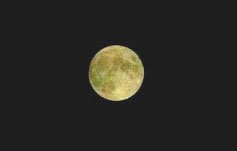
Autumn moon
above a mountain village,
The boom of a temple bell in the distance.
月の夜そぞろ歩きの川明かり
tsuki no yoru sozoro aruki no kawa akari
A stroll on a moon night,
The surface of a river
gleaming.
今日の月ふと立ち止まる通勤路
kyoo no tsuki fu -to tachidomaru tsuukin ro
The harvest moon,
I stop unconsciously
on my way home from office.
Great link about autumn haiku and the Sea. With many pictures.
Thanks go to Wada Yoshio.
http://wadaphoto.jp/haiku5.htm
. . . . .
Two Death Poems (farewell poems) (jisei 辞世(じせい)
about the moon
fude nagete tsuki ni mono iu bakari nari
I throw my brush away -
from now on I speak only
to the moon
Tr. Gabi Greve
or
I cast the brush aside -
from here on I'll speak to the moon
face to face.
Tr. Yoel Hoffman
. Reference
Koha (Kooha) 香波, 1897、August 14
. . .Haiga by greenleaf
(the last line, face to face, has no equivalent in the Japanese).
月も見て我はこの世をかしく哉
tsuki mo mite ware wa kono yo o kashiku kana
I have even seen the moon -
now I can say good bye
to this world
Kaga no Chiyoni, September 8, 1775
.................................................................................
"Beans Full Moon", lesser harvest moon, mame meigetsu 豆名月
also
"Chestnut Full Moon", kuri meigetsu 栗名月
..... a treat served whilst watching the full moon
kigo for late autumn
................................................................................
kigo for mid-autumn
tsukimi 月見 つきみ moon viewing
..... kangetsu 観月(かんげつ)
tsuki matsuru 月祭る(つきまつる)celebrating the moon
tsuki o matsu 月を待つ(つきをまつ)waiting for the moon
see also "entertaining visitors for moon viewing" above.
tsukimizuki 月見月(つきみづき)
month when we can see the moon
. tsukimi mame 月見豆(つきみまめ)
Edamamebeans when viewing the moon
tsukimizake, 月見酒(つきみざけ)rice wine for moon viewing
. "Sweet Potato Full Moon" imo meigetsu 芋名月
Offering sweet potatoes to the deities
:::::::::::::::::::::::::::::::::::::::::::::::::::::::::::::::::::::::::::::::::::::::::::::::::::::
blackberry moon
an american indian (choctaw) name for the october moon
blackberry moon . . .
midnight rain lingers
in a snail's shell
- Shared by Sandi Pray, USA -
Joys of Japan, October 2012
:::::::::::::::::::::::::::::::::::::::::::::::::::::::::::::::::::::::::::::::::::::::::::::::::::::
"Blood Moon" and eclipses geshoku 月食
. Blue Moon .
"once in a blue moon"
:::::::::::::::::::::::::::::::::::::::::::::::::::::::::::::::::::::::::::::::::::::::::::::::::::::
Bow-string moon, gengetsu 弦月
small quater-moon, crescent moon
kigo for autumn
"Bow-stretched moon", yumiharizuki 弓張月
xxxxxxxxxxxxxxxxxxxxxxxxxxxxxxxxxxxxxx
Christmas Moon Weihnachtsmond
"cold moon", moon in a cold nicht
(kan no tsuki 寒の月)
kigo for winter
cold moon -
shards of light
on frost
Ella Wagenmakers
:::::::::::::::::::::::::::::::::::::::::::::::::::::::::::::::::::::::::::::::::::::::::::::::::::::
Dawn moon in autumn (ariakezuki) Japan. 有明月(ありあけづき)
moon in the morning, asazuki/moon left over, nokoru tsuki/mist in the morning, ariake gasumi
:::::::::::::::::::::::::::::::::::::::::::::::::::::::::::::::::::::::::::::::::::::::::::::::::::::
dumplings for moon viewing, tsukimi dango, tsukimidango 月見団子
They are placed on a beautiful tray and put outside as an offering to the deities on the autumn full moon night. Later on, they are eaten by the family.
susuki すすき grasses (another kigo for the full autumn moon season) are put in a vase beside them.
Click HERE to see some photos.
entertaining visitors for moon viewing,
tsuki no za, 月の座
..... tsuki no en 月の宴
host who invited for moon viewing, tsuki no aruji, 月の主
guests viewing the moon togheter, tsuki no kyaku, 月の客
friends viewing the moon together, tsuki no tomo 月の友
moon viewing restaurant, tsukimijaya 月見茶屋 (つきみじゃや)
boat for moon viewing, tsukimibune 月見船
drinking sake while moon viewing, tsukimizake 月見酒
kigo for mid-autumn
:::::::::::::::::::::::::::::::::::::::::::::::::::::::::::::::::::::::::::::::::::::::::::::::::::::
Evening moon, yuuzuki 夕月
Night moon, yoizuki 宵月
Moon of tonight, kyoo no tsuki 今日の月
the moon tonight, koyoi no tsuki 月今宵
kigo for mid-autumn
:::::::::::::::::::::::::::::::::::::::::::::::::::::::::::::::::::::::::::::::::::::::::::::::::::::
Full Moon (mangetsu 満月)
auspicious moon, mochizuki 望月, meigetsu 名月
kigo for mid-autumn
full moon
keeping an eye
on the stars
full moon
wolf howling
your side of the fence
Ella Wagemakers
o o o o o
There is an Ezine called "Full Moon"
http://fullmoonmag.bravehost.com/index.html
. tsuki 月 (つき) moon, der Mond
The Full Moon of Autumn ... more KIGO
:::::::::::::::::::::::::::::::::::::::::::::::::::::::::::::::::::::::::::::::::::::::::::::::::::::
France, names of the moon
new moon, nouvelle lune (French)
shingetsu / saku (" new moon")
new crescent, croissant (French)
mikazuki ("the third day's moon")
half-moon, premier quartier (French)
hangetsu ("half-moon"),
jougen no tsuki("an upward bow" )
full moon, pleine lune (French)
mangetsu, mochizuki("full moon"),
juugoya ("the fifteenth night")
half-moon, dernier quartier (French)
hangetsu ("half-moon"),
kagen no tsuki ("a downward bow")
http://www.asahi-net.or.jp/~NW6E-MTMR/moon/name_e.htm
:::::::::::::::::::::::::::::::::::::::::::::::::::::::::::::::::::::::::::::::::::::::::::::::::::::
Germany, names of the moon
Namen des Mondes
Januar: Hartmond, Eismond, Schneemond, Wolfsmond
Februar: Narrenmond, Schmelzmond, Taumond
März: Frühlingsmond
April: Ostermond
Mai: Weidemond, Wonnemond, Marienmond
Juni: Brachmond, Rosenmond
Juli: Heumond
August: Erntemond, Sichelmond
September: Herbstmond
Oktober: Weinmond, Dachsmond
November: Nebelmond, Wintermond, Windmond
Dezember: Julmond, Christmond, Heiligmond, Wolfsmond, Schlachtmond
www.wetter-mensch-natur.de
:::::::::::::::::::::::::::::::::::::::::::::::::::::::::::::::::::::::::::::::::::::::::::::::::::::
Harvest Moon, North America
Hunger Moon
Hunter's Moon
:::::::::::::::::::::::::::::::::::::::::::::::::::::::::::::::::::::::::::::::::::::::::::::::::::::
. WKD : Ice Moon - February
'Moon of the Dark Red Calf'
India
Moon, waxing (moondraam pirai)
:::::::::::::::::::::::::::::::::::::::::::::::::::::::::::::::::::::::::::::::::::::::::::::::::::::
Moon Names
Colonial American
Chinese
American Indian (Choctaw)
American Indian (Dakotah Sioux)
Celtic
English Medieval
Neo Pagan
New Guinea
source : krcool
:::::::::::::::::::::::::::::::::::::::::::::::::::::::::::::::::::::::::::::::::::::::::::::::::::::
. Meigetsu 名月 (Japan)
The full moon of Mid-Autumn (September)
"famous moon". The full moon of the eighth lunar month, usually in September.
also translated as : harvest moon.
kigo for mid-autumn
:::::::::::::::::::::::::::::::::::::::::::::::::::::::::::::::::::::::::::::::::::::::::::::::::::::
.. .. .. .. .. .. .. .. .. MOON
handblown glass -
cirrus clouds curve
around the moon
Hortensia Anderson
oo oo oo oo oo
moonlit bridge –......................... яркая луна --
my shadow checks the path .......тень нащупывает путь
before my steps .........................по мостику
Origa (Olga Hooper)
Read more of Origa's Moon Haiku here:
http://www.livejournal.com/users/origa/30603.html?nc=12
:::::::::::::::::::::::::::::::::::::::::::::::::::::::::::::::::::::::::::::::::::::::::::::::::::::
MOON kigo for mid-autumn
New Moon, shingetsu 新月, 初月
the moon appears small for the first time in the eigth month of the lunar calendar, now September. Crescent moon.
New Moon on the second day, futsukazuki 二日月
..... sengetsu 繊月(せんげつ)
..... futsuka no tsuki 二日の月(ふつかのつき)
New Moon on the third day, mikkazuki 三日月
..... mikka no tsuki 三日の月(みっかのつき, tsuki no mayu 月の眉(つきのまゆ), mayugakizuki 眉書月(まゆがきづき), mayuzuki 眉月(まゆづき), mikkazuki mayu 三日月眉(みかづきまゆ)
..... new moon, shingetsu 新月(しんげつ), young moon, jakugetsu 若月(じゃくげつ)
..... sword of the moon, tsuki no tsurugi 月の剣(つきのつるぎ)
..... gabi 蛾眉(がび), shohaku 初魄(しょはく)
No Moon (mugetsu, 無月 Japan)
The "invisible moon" , refers to the night of the full moon in September, when he is hidden by the clouds.
When it rains on that day, we have the "rain moon", ugetsu 雨月.
:::::::::::::::::::::::::::::::::::::::::::::::::::::::::::::::::::::::::::::::::::::::::::::::::::::
October Full Moon (nochi no tsuki 後の月)
kigo for late autumn
"the next full moon"
Spetember in the Asian lunar calendar. In America: Hunter's Moon.
The moon a month after the really bright moon of august.
nochitsuki no kanashiki hodo no shirosa kana
October full moon
moonshine is too white
for sadness
Etsuko Yanagibori
:::::::::::::::::::::::::::::::::::::::::::::::::::::::::::::::::::::::::::::::::::::::::::::::::::::
paper moon
topic for haiku
Paper Moon is a 1973 American comedy film directed by Peter Bogdanovich and released by Paramount Pictures. The screenplay was adapted from the novel Addie Pray by Joe David Brown, and the film was shot in black-and-white. The film is set in Kansas and Missouri during the Great Depression. It stars the real-life father and daughter pairing of Ryan and Tatum O'Neal, as on-screen father and daughter Moze and Addie.
© More in the WIKIPEDIA !
Poacher's Moon
Snow Moon
kigo for winter
:::::::::::::::::::::::::::::::::::::::::::::::::::::::::::::::::::::::::::::::::::::::::::::::::::::
Spring Moon kigo for all spring
Vollmond im Frühling
. . . CLICK here for Photos !
haru no tsuki 春の月 moon in spring
... shungetsu 春月(しゅんげつ)
haruzukiyo 春月夜(はるづきよ)night with a spring moon
haru mangetsu 春満月(はるまんげつ)full moon in spring
haru mikazuki 春三日月 (はるみかづき) crescent moon in spring
... 春の三日月(はるのみかづき)
oborozuki 朧月 (おぼろづき) hazy moon in spring

tsuki oboro 月朧(つきおぼろ)moon is hazy
oborozukiyo 朧月夜(おぼろづきよ)night with a hazy moon
tangetsu 淡月(たんげつ) lightly hazy moon
. . . CLICK here for Photos !
Spring Moon Haiga
Beautiful Haiga by Victor P. Gendrano
http://www.geocities.com/vgendrano/moon.html
:::::::::::::::::::::::::::::::::::::::::::::::::::::::::::::::::::::::::::::::::::::::::::::::::::::
Sugar Moon / Sap Moon Full Worm - March Moon. Maple Moon.
North America and Canada. Making Maple Syrup.
:::::::::::::::::::::::::::::::::::::::::::::::::::::::::::::::::::::::::::::::::::::::::::::::::::::

Young woman viewing the summer moon
Suzuki Harunobu (1725-1770)
Summer moon
natsu no tsuki 夏の月 (なつのつき) moon in summer
summer moon
It refers to a cool evening (tsuki suzushi 月涼し)
It has been the subject of many poems since old times, when people enjoyed the full moon on a cool summer night.
When it shines on the earth, it colors the ground white "like frost" (yoru no shimo 夜の霜), to bring a cool feeling to the viewer.
. cool moon, tsuki suzushi 月涼い
takotsubo ya hakanaki yume o natsu no tsuki
Basho and the Octopus pot
夏の月無きずの夜もなかりけり
natsu no tsuki mukizu no yoru mo nakari keri
summer moon--
there's no such thing
as a flawless night
Issa
(Tr. David Lanoue)
late summer moon . . .
the remnants of a gull’s wake
floats on the river
Bruce Ross , Bangor, ME, USA
http://mdn.mainichi.co.jp/haiku/03/selection2002.html
.................................................................................
kigo for mid-summer
tsuyu no tsuki 梅雨の月 (つゆのつき)
moon in the rainy season
. tsukimizu tsuki 月見ず月(つきみずつき)
month when we can not see the moon
:::::::::::::::::::::::::::::::::::::::::::::::::::::::::::::::::::::::::::::::::::::::::::::::::::::
Snow and Moon
. . yukizukiyo 雪月夜(ゆきづきよ)
night with snow and a full moon
Yukitsukiyo
I read your Haiku
before sleep
Etsuko Yanagibori
:::::::::::::::::::::::::::::::::::::::::::::::::::::::::::::::::::::::::::::::::::::::::::::::::::::
WINTER MOON
fuyu no tsuki 冬の月 (ふゆのつき) winter moon, moon in winter
tsuki sayuru 月冴ゆる(つきさゆる)brigh clear winter moon
tsuki kooru 月氷る(つきこおる)"freezing moon"
kangetsu 寒月(かんげつ)"moon in the cold", moon on a cold night
("cold moonlight" is something else.)
fuyu mikazuki 冬三日月(ふゆみかづき)cresecent moon in winter
kan mikazuki 寒三日月(かんみかづき) crescent moon in the cold
- - - - - Yosa Buson - - - - -
寒月や開山堂の木の間より
kangetsu ya kaisandoo no ki no ma yori
this cold moon -
among the trees
of the founder's hall
- - - - -
寒月や枯木の中の竹三竿
kangetsu ya kareki no naka no take sankan
this cold moon -
among the bare trees
three stalks of bamobo
- - - - -
寒月や小石のさはる沓の底
kangetsu ya koishi no sawaru kutsu no soko
this cold moon -
the soles of my shoes
touch small pebbles
- - - - -
寒月や松の落葉の石を射る
kangetsu ya matsu no ochiba no ishi o iru
this cold moon -
fallen needles of pines
shoot into stones
- - - - -
寒月や門を敲ば沓の音
kangetsu ya mon o tatakeba kutsu no oto
this cold moon -
after knocking at the (temple) door
the sound of wooden clogs
- - - - -
寒月や鋸岩のあからさま
kangetsu ya nokogiri-iwa no akara sama
this cold moon -
the red glow
on Nokogiri-Iwa rocks
ーPossibly
. Nokogiriyama 鋸山 Mount Nokogiri . Chiba prefecture
nokogiri - saw
- - - - -
寒月や衆徒の群議の過ぎて後
kangetsu ya shuuto no gungi no sugite nochi
this cold moon -
after the monk-soldiers left
the war meeting
monk-soldiers (soohei 僧兵) armed monks of the Heian period and later, mostly adherent to the large temples in Kyoto and other regions of Japan.
- - - - -
寒月や僧に行き合ふ橋の上
kangetsu ya zoo ni yuki-au hashi no ue
this cold moon -
I meet a monk
on the bridge
. Yosa Buson 与謝蕪村 and the moon .
- - - including
寒月に木を割寺の男哉
kangetsu ni ki o waru tera no otoko kana
寒月や門なき寺の天高し
kangetsu ya mon naki tera no ten takashi
kangetsu ya tani ni cha o kumu mine no tera
.......................................................................
寒月や我ひとり行く橋の音
kangetsu ya ware hitori yuku hashi no oto
moon in the cold -
only my own footsteps
on the bridge
Tan Taigi 炭太祗
Tr. Gabi Greve
cold moonlight
through the window
still no dreams
source : Haiku Bandit Society, March 2009
:::::::::::::::::::::::::::::::::::::::::::::::::::::::::::::::::::::::::::::::::::::::::::::::::::::
Haibun about the Moon
by Takashi Nonin
http://www.haikupoetshut.com/themoon.html
We have only to say "the moon" when we refer to the autumnmoon. We must therefore put such epithets as "spring/vernal", "summer", or "winter" before the moon when we mention the other season's moon.The autumn moon makes the difference. My old SAIJIKI has 126 words or phrases with regard to the autumn moon. Which shows how profoundly the Japanese have affiliated with the moon since ancient times.
Today, October 5th (September 15th according to the lunar calendar) is the Full Moon. Tonight TV stations across the Archipelago telecast the full moon with a few seasonal comments. "A poet can not but be jocund." We look up and admire the moon tonight.When it happens to be cloudy and we cannot see the moon, we don't complain but try to see the "invisible" moon way beyond the clouds.
This is Mugetsu or No Moon. When it's raining, we call the Rainy Moon Ugetsu 雨月. We miss the moon, to which our thoughts go out through the rain.We praise the moon and enjoy everything about the way the moon looks tonight. Eared pampas grass and several other flowering plants fresh from the autumn fields arranged in a vase, together with"moon-viewing dumplings"(Tsukimi-dango) are placed near the open window as the gifts for the moon.
Our hearts are filled with anticipation on the Eve of the Full Moon (Oct.4th this year). This is Matsuyoi or The Moon-awaiting Evening.
:::::::::::::::::::::::::::::::::::::::::::::::::::::::::::::::::::::::::::::::::::::::::::::::::::::
Sitting all alone
facing a still white paper:
behind me the moon
Vasile Moldovan
Read more about the Moon in Europa
:::::::::::::::::::::::::::::::::::::::::::::::::::::::::::::::::::::::::::::::::::::::::::::::::::::
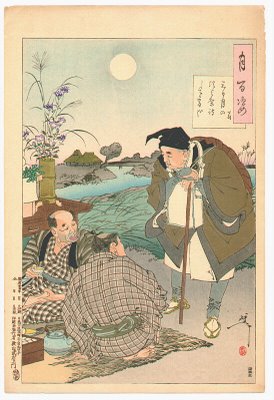
三日月の 頃より待ちし 今宵かな
mikazuki no koro yori machi shi koyoi kana
since the sickle moon
we waited so impatiently
for the moon tonight
Matsuo Basho,
the last woodblock print in the following series
One Hundred Aspects of the Moon
Tsuki Hyakushi 月百姿
by Tsukioka Yoshitoshi (1839-1892)
One Hundred Aspects of the Moon is the last major work of Yoshitoshi. 100 Aspects of the Moon consists of a hundred single sheets with very diverse subjects and only one common theme - the moon, more or less visible on each design.
Read the full article with more prints here:
© Artelino.com Art
Here is my dear Daruma in this MOON series
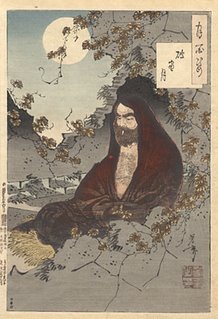
© GALERIE AM HAUS DER KUNST • MÜNCHEN
Yoshitoshi's moon prints on display in Leiden, Holland
By MARJAN BEX, November 2006
Harvest Moon and Geese Haiku / WHR 3
:::::::::::::::::::::::::::::::::::::::::::::::::::::::::::::::::::::::::::::::::::::::::::::::::::
harvest moon above
lights the evening sky
silver fields below
Paul Oxberry, October 2007
:::::::::::::::::::::::::::::::::::::::::::::::::::::::::::::::::::::::::::::::::::::::::::::::::::::
Super Moon May 2012

photo : Maya Lyubenova, 05 May 2012; Plovdiv, Bulgaria
between us
there also lives
super moon
- Shared by Louis Osofsky -
super moon-
pull me closer to the sea
out beyond the surf
- Shared by Lisa Hills -
Joys of Japan, May 2012
the pond’s depth ~
this perigee moon
reflection
- Shared by Elaine Andre -
Joys of Japan, 2012
:::::::::::::::::::::::::::::::::::::::::::::::::::::::::::::::::::::::::::::::::::::::::::::::::::::

supermoon...
the craters closer
ever closer
a couple on the pier
peer into eachother
- Shared by Dennis Chibi -
Joys of Japan, 2012
:::::::::::::::::::::::::::::::::::::::::::::::::::::::::::::::::::::::::::::::::::::::::::::::::::::

at midnight
the last gift of Golden Week
a silver supermoon
- Shared by Kit Nagamura -
Joys of Japan, 2012
:::::::::::::::::::::::::::::::::::::::::::::::::::::::::::::::::::::::::::::::::::::::::::::::::::::
my old dog
gazing at the supermoon
I fall asleep
Chen-ou Liu
Kigo Hotline
The perigee full moon on May 5, 2012 will be as much as 14 percent bigger and 30 percent brighter than other full moons of 2012.
LOOK at the NASA video here:
source : www.nasa.gov
:::::::::::::::::::::::::::::::::::::::::::::::::::::::::::::::::::::::::::::::::::::::::::::::::::::
:::::::::::::::::::::::::::::::::::::::::::::::::::::::::::::::::::::::::::::::::::::::::::::::::::::
THE HEBREW LUNAR CALENDAR
Nisan was determined by a celestial event.
The Nisan moon was the first moon that would become a full moon after the passing of the spring equinox. Nisan thereby marked the first month of the year on the Hebrew calendar for the religious year. The Nisan moon, confirmed by the ripening of the barley harvest determined the month in which Passover would be celebrated.
source : endtimepilgrim.org
. WKD : Nisan Moon haiku .
:::::::::::::::::::::::::::::::::::::::::::::::::::::::::::::::::::::::::::::::::::::::::::::::::::::
WASHOKU ... Japanese Food SAIJIKI
[ . BACK to WORLDKIGO . TOP . ]
:::::::::::::::::::::::::::::::::::::::::::::::::::::::::::::::::::::::::::::::::::::::::::::::::::::



